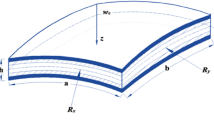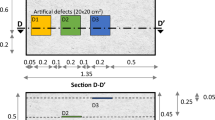Abstract
To identify planar heterogeneities or flaws inside a structure using ultrasonic tests, it is necessary to characterize reflections originating from the boundaries of the heterogeneities. However, for composite materials with high, frequency-dependent wave attenuation, it is often not possible to clearly identify the reflections with either A-scan signals or conventional deconvolution techniques due to the combined effect of signal distortion and overlap. To enable deconvolution of a distorted propagating wave, a new time domain deconvolution technique which includes the frequencydependent acoustic properties of the host material has been developed. This approach is shown to be superior to conventional time domain deconvolution with L1 norm minimization in resolving flaw reflections in highly attenuative glass fiber reinforced polyurethane composites.
Similar content being viewed by others
References
K. I. McRae, Deconvolution techniques for ultrasonic imaging of adhesive joints,Mater. Eval. 1380–1384 (1990).
K. McRae, C. Zala, and I. Bailey, Real time super-resolution signal processing applied to the ultrasonic imaging of adhesively bonded joints, inReview of Progress in Quantitative NDE, Vol. 9A, D. O. Thompson and D. E. Chimenti, eds. (Plenum Press, New York, 1990), pp. 641–646.
K. McRae, and C. Zala, Improved axial resolution of ultrasonic B-scans by L1-norm deconvolution, inReview of Progress in Quantitative NDE, Vol. 7A, D. O. Thompson and D. E. Chimenti, eds. (Plenum Press, New York, 1988), pp. 747–756.
G. Hayward, and J. E. Lewis, Comparison of some non-adaptive deconvolution techniques for resolution enhancement of ultrasonic data,Ultrasonics 27:155–164 (1989).
H. L. Taylor, S. C. Banks, and J. F. McCoy, Deconvolution with the L1 norm,Geophysics 44:39–52 (1979).
C. A. Barrodale, C. A. Zala, and N. R. Chapman, Comparison of the L1 and L2 norms applied to one-at-a-time spike extraction from seismic traces,Geophysics 49:2048–2052, (1984).
M. S. O'Brien, A. N. Sinclair, and S. M. Kramer, High resolution deconvolution using least-absolute-values minimization,1990 IEEE Ultrasonic Symposium 1151–1156.
J. F. Claerbout, and F. Muir, Robust modeling with erratic data,Geophysics 38:826–844, (1973).
J. Krautkramer, and H. Krautkramer,Ultrasonic Testing of Materials (Springer-Verlag, 1983).
D. K. Hsu, H. Jeong, Ultrasonic velocity change and dispersion due to porosity in composite laminates, inReview of Progress in Quantitative NDE, Vol. 8B, D. O. Thompson and D. E. Chimenti, eds. (Plenum Press, New York, 1987), pp. 1567–1573.
P. B. Nagy, and L. Adler, Ultrasonic evaluation of dissimilar solid-state bonds, inReview of Progress in Quantitative NDE, Vol. 8B, D. O. Thompson and D. E. Chimenti, eds. (Plenum Press, New York, 1987), pp. 1965–1972.
Author information
Authors and Affiliations
Rights and permissions
About this article
Cite this article
Huang, H.A., Bakis, C.E., Hahn, H.T. et al. An adaptive time domain deconvolution technique to characterize planar flaws in highly attenuative composites. J Nondestruct Eval 13, 101–109 (1994). https://doi.org/10.1007/BF00728249
Received:
Revised:
Issue Date:
DOI: https://doi.org/10.1007/BF00728249




